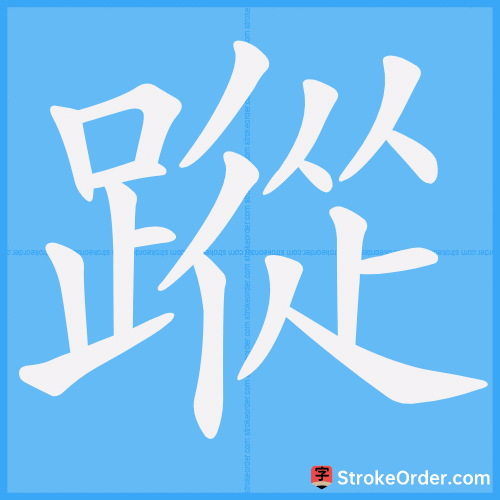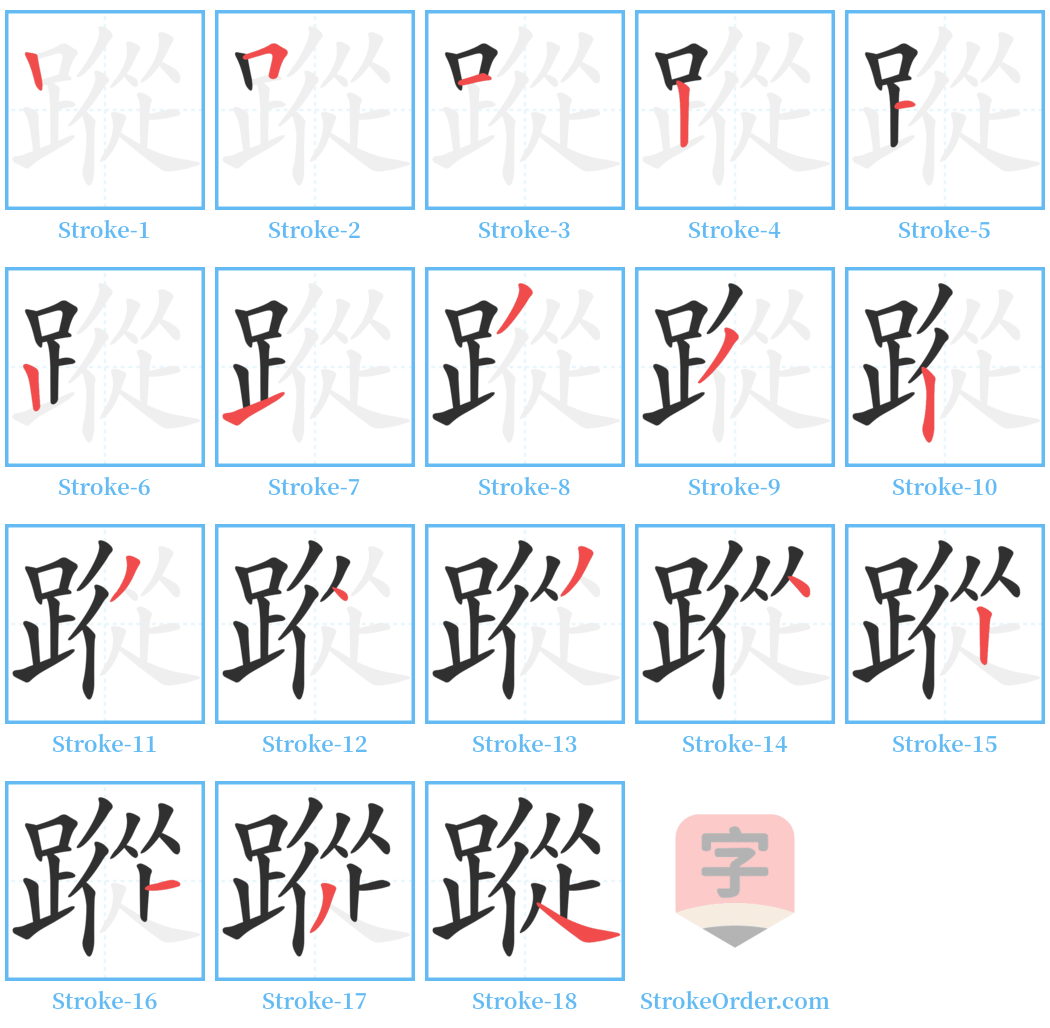蹤 Stroke Order
Animated Stroke Order of 蹤

Stroke Order Diagrams for 蹤

Step-by-Step Handwriting Guide for 蹤

Learn to Write Chinese Characters with Video Tutorials
Watch the video of writing the Chinese character "蹤", learn the correct stroke order (笔顺) of the character "蹤", and master the standard way of writing the character "蹤".
Free Printable Handwriting Practice with Stroke Order: 蹤
Printable Writing Practice Worksheet of "蹤" in Portrait Orientation (Tian Zi Ge)

Printable Writing Practice Worksheet of "蹤" in Landscape Orientation (Tian Zi Ge)

Information of 蹤
Pinyin
zōng
Radical
足
Strokes
18 strokes
Usage
★★★
Definition
footprint / trace / tracks
蹤
蹤 zōng
[名]
【本义】: 腳印,蹤跡
[Base Meaning]: Footprints; traces
1. 腳印;蹤跡。後作“蹤”。
[1] Footprints; traces. Later written as “蹤”.
例: 《釋名•釋言語》:“蹤,從也,人形從之也。”
Example: "Zōng refers to following; a human form follows it."
《玉篇•足部》:“蹤,蹤跡也。”
Example: “Zōng refers to traces.”
2. 追隨;追蹤。
[2] To follow; to trace.
例: 《晋書•劉曜載記》:“義孫年長明德,又先世子也,朕欲遠追周文,近蹤光武,使宗廟有太山之安。”
Example: "I want to trace the way of Zhou Wen and closely follow Guangwu, for the tranquility of the ancestral temple."
3. 縱身。
[3] To leap.
例: 明沈璟《義俠記》第四回:“閃的它回身處撲着空,轉眼處亂着蹤。”
Example: "It hurriedly turned and leaped into the void."
4. 姓。
[4] A surname.
例: 宋鄧名世《古今姓氏書辯證•鍾韻》:“蹤,今開封市人有此姓。莫知所自出。”
Example: "Zōng is a surname found in present-day Kaifeng; its origins are unknown."
【引】
引例:
1. 李白《謁老君廟》:“草合人蹤斷,塵濃鳥跡深。”
Lie Bai's poem: "The grass covers the traces of man, and the dust thickens the bird's footprints."
2. 柳宗元《江雪》:“千山鳥飛絕,萬徑人蹤滅。”
Liu Zongyuan's poem: "In thousands of mountains, the birds no longer fly; in myriad paths, the traces of men have vanished."
3. 宋·蘇軾《石鐘山記》:“訪其遺蹤。”
Song Su Shi's: "Visit its remaining traces."
4. 《聊齋志異·促織》:“絕無蹤響。”
Liao Zhai Zhi Yi: "Absolutely no traces of sound."
5. 《廣東軍務記》:“膽寒潛蹤。”
Guangdong Military Records: "With fear in one’s heart, one stealthily follows."
例:
又如: 蹤塵(塵世的事情); 蹤緒(蹤跡,頭緒); 蹤響(蹤跡和聲響); 蹤轍(蹤跡)
Example: Such as traces of the world (蹤塵); clues (蹤緒); echoes of traces (蹤響); tracks (蹤轍).
【引】
引例:
1. 《鹿虔扆·臨江仙》:“翠華一去寂無蹤,玉樓歌吹,聲斷己隨風。”
Lu Qianyi: "When the emerald splendor departs, there is silence; in the jade tower, the songs cease as they follow the wind."
例:
又如: 蹤由(事情的始末); 跟蹤
Example: Such as the course of events (蹤由); to follow closely (跟蹤).
[動]
追隨 (【英】:follow)
To follow (follow)
【引】
引例:
1. 《晉書·劉曜載書》:“朕欲遠追周文,近蹤光武,使宗廟有太山之安。”
Jin Shu: "I desire to trace Zhou Wen from afar and closely follow Guangwu, ensuring tranquility for the ancestral temple."
2. 《隋書》:“質菲薄而難蹤,心恬愉而去惑。”
Sui Shu: "The quality is thin and hard to trace, yet the heart is calm and happy, free from confusion."
例:
又如: 蹤行(跟着走)
Example: Such as to follow (蹤行).